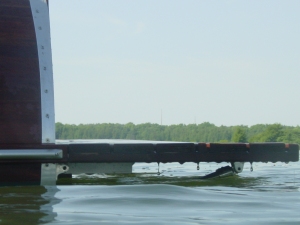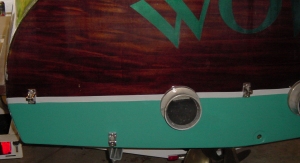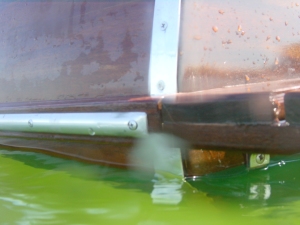This spring we did some major work on our Riviera. The boat is primarily used for water sports and is left in the water all summer long. Between the UV exposure and the constant climbing over the hull, the varnish finish had taken a beating. This lead to completely refinishing the deck and sides of the boat. We also wanted to enhance its use for wake boarding, skiing and tubing. For this we added a wakeboard pylon and swim platform. As you will see in the coming photos and articles, these items can play well with a classically styled boat.
We
had been entering the boat with a ladder attached over the transom. The ladder
was removable and would fit into two clips at the top of the transom. Putting
the ladder in and removing it every time we picked up a skier was a hassle.
The ladder was in the way for waterski and wakeboard storage and was causing
its share of damage to the boat. While the ladder was huge improvement over
simply hoisting ourselves over the sides (not easy at all), we wanted a swim
platform as we had seen on competition ski boats.
This photo shows our daughter, Jessie coming up the ladder as it was mounted over the transom.
The next step was coming up with hardware to mount the swim platform. It had to look good, be quite stiff and be removable. After scouring the web, posting queries on rec.sport.waterski, etc., I was a bit disappointed. Basically either I could:
The bimini top brackets are a 2 piece assemblies that are made to mount to a flat surface and then hold onto a 1" diameter tube. The tubular end swivels in the rougly U shaped bracket. A screw with a shoulder is the pivot pin. The shoulder prevents the threads from damaging the mating swivelling tube piece. These are fairly heavy and solid stainless. Some other units were merely plated zinc or Zamac which I thought would surely break under the loads that I would apply.
The forward edge of the swim platform is attached to the boat in 3 places. There are also 2 diagonal supports that hold up the outside edge. To attach the forward brackets to the platform, I had to make three metal brackets form 1/2x 1" stainless. These pieces were notched to mate with the brackets at a 5 degree angle. This "straightens the alignment to compensate for the curvature of the transom. Note however, that the castings are not terribly precise and each had o be machined slightly differently for a snug fit. Once they fit, the pivot hole was drilled. Each bracket is held onto the swim platform by several 2" #12 wood screws. The brackets are drilled and countersunk to provide a nice smooth look. The brackets were finally belt sanded to remove he mill scale and give them a nice brushed look. The only stainless bar stock locally available was #304. This stuff is terrible to work. It work hardens easily and is very tough on milling cutters and drill bits. The side brackets are 6" long and the center one is 12" long. They really could all have been the same length.
The diagonal braces are 1" stainless tubing and are approximately 14.5" long. It is easily cut with a standard plumbing tubing cutter. After final assembly and fitting, there are small set screws that lock everything together.
Total cost for the hardware including replacement bits was about $160
The platform is made up of parallel 1x4" (0.75x3.5" net) slats for the top and then 1x4" support pieces arranged roughly perpendicularly underneath. The construction is very simple lap joints, which raises concerns about rigidity and structural integrity. At each support point, there is a slat that runs the width of the platform. I did not want a support simply fastened to the top layer and all of the fasteners then held in tension.
There are seven front to back support slats on the bottom. They are arranged with two at each outside edge, one in the center and then one on each side , approximately 25% of the way in from each side to mount the diagonal braces.
The slats are spaced 1/4" apart to allow for expansion and for water to drain off. The finger slot is created by spacers strips that are 3/4" wide and have the same 1/4" spacing between the planks. This leaves a new finger slot size of approximately 1.25"x12". This is easy to grab and wide enough to prevent fingers getting trapped, which may occur if the slot was too narrow. I am not sure if this a real consideration, but the newest ski boat swim platforms no longer have finger slots.
The two layers are held together with 3M 5200 and #12 1.25" flat head
stainless wood screws. Screwing it together was provably the hardest part. The
pieces need to be clamped together as the 5200 is very viscous and does not
easily compress evenly for full contact. The Ipe is VERY hard and requires good
pilot holes and countersinks. It can split near the ends if the pilot is not
right. At each board junction I used 2 screws, placed diagonally across the
joint to minimize the chances of splitting.
The area between the lower layer support slats is filled at the rear edge with blocks. This gives the appearance from the edge that the swim platform is a solid 1.5" thick piece. The lighter appearing pieces on the lower layer are the infill. The darker pieces are the ends of the cross support slats.
The sides are curved to extend the contour of the side of the boat. The piece removed from the front cockpit deck frame was used to set the curve. It was handy and looked about right. The sides step in about 1.5" in 18"
The back is curved slightly and the curve starts about 1/3 of the way across and cuts off about 1.25" at the outside edges. There are really no critical dimensions. Play with the layout while it is sitting on the bench or floor until you have something pleasing.
The curves were cut on the band saw and with a sabre saw. The edges were planed and scraped smooth.

Once the platform was assembled and then brought up to the boat. Temporary 3/8" spacer blocks were laid on the exhaust ports to support it above the exhaust. I did not want it permanently resting on the exhaust ports or rubbing against them. The outer edge was held up by a piece of plywood clamped vertically in my Work Mate. This setup was quite stable and then allowed me to scribe a line along the forward edge to match the boat transom. A spacer was used with a pencil to mark the scribe line on the platform. The scribe marking spacer was cut to width so that the line ended about 3" in from the ends. This means that the very ends of the platform are flat (not perfectly conforming to the transom), but has the advantage of avoiding small points that would break off over time. The curve was cut on the band saw and then scraped.
The forward edges were routed with a 1/8" round over bit. This approximately matched the edge round over of the planks. The rear edge was routed with 1/4" round over bit. The sides were left square for the moment to make alignment with the spray rails easier.
The assembly was again brought back up and braced in position. The outer brackets were temporarily clamped on and the holes were marked on the transom. The outer brackets holes were then drilled and sealed with epoxy. The brackets were bedded in 5200 and through bolted. The alignment is such that the bolts passed though the transom plywood and the curved interior frame pieces. This meant that interior blocking was not required. The center bracket position was simply drilled and screwed in place. It was not through bolted as it was not accessible on the inside without removing the gas tank (which was still full for the winter).
I like the idea of through bolting as it is easy to swing the swim platform into boats, docks, etc while turning and did not want it to come off. The brackets were screwed to the underside of the platform with #12 2" wood screws and bedded in more 5200. Did you know that 5200 also makes a nice screw lubricant to assist in driving screws?
 The
angle brackets were screwed in place both on the platform and on the transom.
The brackets on the transom are screwed through the transom into some very substantial
interior framing and are simply held with #12 3" screws and bedded in 5200.
The
angle brackets were screwed in place both on the platform and on the transom.
The brackets on the transom are screwed through the transom into some very substantial
interior framing and are simply held with #12 3" screws and bedded in 5200.
This left photo also shows the angle bracket and the top center mounting bracket as well.
The right photo is another view showing the cross piece that the diagonal bracket is mounted to as well as more clearly showing the infill piece at the rear edge.
 This is a shot of the same bracket as viewed from the underside. These are
"Heavy Duty Bimini Top" brackets.
This is a shot of the same bracket as viewed from the underside. These are
"Heavy Duty Bimini Top" brackets.
These two photos show the brackets I made to mount the platform to the transom. The longer bracket is in the center. The whorter bracket is for the left edge.


Here are a couple of shots of the "bimini top" brackets mounted on the transom. The pieces shown above fit into them to hold the swim platform on.



The spray rails are cut from a 2x4 piece of Ipe (1.5" thick net). They are approximately 1.25" wide at the front and 1.75" wide at the back. They are scribed to fit the hull. This fitting took about an hour each as the sides of the boat curve in both the horizontal and vertical directions. Hand plans and scrapers were used. A curved scraper was very handy in dishing along the length of the piece to match the vertical curvature (tumblehome) of the sides. The Ipe is extremely stiff and there was really no pulling the gap shut with screws.
The spray rails were through bolted and fender washers were used on the inside to avoid crushing the okoume plywood. The spray rails were bedded in Sikaflex (they may have to be removed some day). The bolt holes were plugged. With the mahogany colored Sikaflex, the joint line is nearly invisible.
At this point the final fitting of the outer contour was done by planing the spray rails to match the swim platform. The edges of the spray rails and swim platform were then routed with a 1/4" round over bit. This photo shows the joint between the swim platform and the spray rail.
Stainless half oval trim was applied for wear resistance. The cut ends were beaten flat (big hammer and steel plate). Next, they were filed to shape and then sanded to with 600 and 1000 grit emery paper and then polished. The half oval pieces were screwed onto the spray rails. I chose not to put any on the swim platform.
The entire surface is scraped smooth. All the corners are rounded over as well. The wood was coated with a couple of coats of Penofin. It is recommended by a friend of mine who works for the importer (http://www.ironwoods.com/). I have used this on outdoor Ipe furniture in the past. It makes for an amazingly good color match to the mahogany.

My wife says that the swim platform is the best addition I have made to the boat. It is so easy to get people in and out of the boat with out having to fool around with the ladder. We gained storage space, reduced hassle when changing skiers / boarders and reduced damage to the boat. Additionally. when we anchor out in the lake, the ladder would often come loose due to wave motion. This required that it be tied on or a ski handle draped over the tow eye. No more problems with that.
There aren't photos of the actual construction process. I was in a bit of a rush to get the boat in the water. With everything that needed to be done this spring, platform, pylon and refinish. As a result, I completely forgot to shoot anything until we had the boat in the water.
The photos on the boat in the water were taken with a Sony digital still camera and underwater housing. We use this camera extensively while on the water. The movie clips are great for troubleshooting new tricks and teaching beginners what is going on with their deep water starts.
Copyright 2003, 2004 Mark Bronkalla
This page last modified 5/18/04